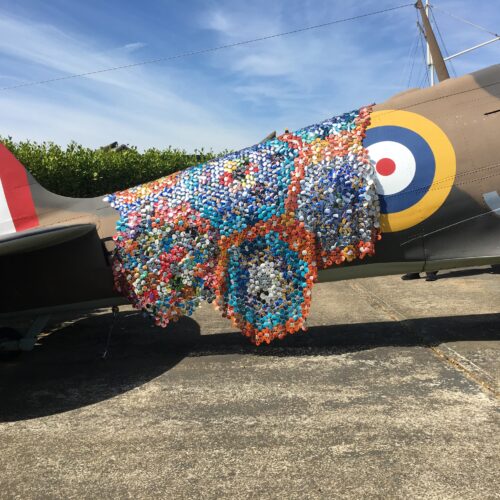
Writing on the Wallhanging
I come back to Rosalind Wyatt’s work once more, because quite simply, her textile art illustrates so many ideas and themes. For the moment, I want to focus on her use of text on fabric, something which often causes concern to students and much sampling and trying out of expensive supplies. I would always encourage students to play with every new material they can find, but sometimes this can become very costly and fortunately, the simplist approaches often turn out to be the best. 
This is a section of Love Letter in which Rosalind has used her own method, called Trans-sewing to stitch out a love letter (sent from Lord Curzon – Viceroy of India to his wife). In fact, the letter is in poem form, from an original Sanskrit/Indian love song. The embroidery is done completely by hand, very painstakingly, which might be thought the opposite of spontaneous artwork – more like that done on old samplers. Strangely though, it has the opposite effect, seeming very loose, the letters forming marks on the cloth in a way that gives them an immediacy like calligraphy, her other artform; the imperfect, flowing quality of handwriting. The writing is on old linen cloth, edged in lace, as Rosalind often takes antique artifacts and embroiders on them. Some viewers might have a problem with this, but she believes she is transforming them, giving them new meaning and poignancy, what do you think?

OCA student, Di Schonhut often uses text within her textile pieces, as she frequently focuses on issues in the news. Text is an important ingredient because it supplies the punch line, making sense of the rest of the composition, but it also forms an essential part of that composition. Her work forces the viewer to think about issues in daily life. Its done is a gentle, tongue in cheek way, but nonetheless with serious intent, as in this piece questioning our contemporary obsession with dieting.
Di has comprehensively experimented with text over a number of courses to find what works for her. Here she uses two methods, free machine embroidery and stencilled wording onto thick non woven fabric. Automatic writing forms on the sewing machine proved too uniform and stilted for her liking, so a quality of randomness has been inbuilt once more with other methods as here.
This second piece of Di’s is was based around a historic but notorious local crime in Hants, the murder of “Sweet Fanny Adams” as she became known. You may know the name, but be unfamiliar with the story, which is a grusome but ultimately sad Victorian tale. 
At first sight this piece looks fairly conventional, almost like a pretty tray cloth, but that would belie its more complicated inner meaning. The writing here is actually more reminescent of the first piece, done by hand with a touching, innocent charm – not by accident of course. Di highlights that the fact that, dispite the horror of the story, for which its remembered, Fanny was still a young, innocent girl and should be remembered this way. The colours are kept fairly light, sweet and pretty to reflect this and the writing is childlike, even fey, not the heavy, solidly carved feel that one might expect on a funereal monument. This keeps the effect pretty and sweet and ultimately about Fanny, rather than the crime. I feel this piece has a wonderful poinancy about it and its a great example of wording used to create an effect, so much said in those few simple words and the way they are constructed.
Trisha Goodwin, Textiles tutor






The innocent charm of the needlework in the last piece is also reminiscent of the sort of stitching Fanny herself might have done on a sampler. All three pieces have great charm in very different ways.
Penny
The work of Dutch textile artist Tilleke Schwarz also uses text to great effect. Similarly, at first glance it has a sense of immediacy and perhaps casualness in its placement, yet the embroidery itself is incredibly fine and the compositions exquisite in their consideration and use of space – Schwarz has no fear in leaving large areas of the background completely untouched. Like a magpie, she gathers all kinds of bits and pieces from daily life and brings together disparate segments of text to create thought-provoking juxtapositions that can be read in multiple ways. http://www.tillekeschwarz.com